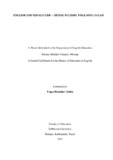Please use this identifier to cite or link to this item:
https://elibrary.tucl.edu.np/handle/123456789/3536| Title: | English and Nepali Code – Mixing in Limbu Folk Song Palam |
| Authors: | Limbu, Yagya Bahadur |
| Keywords: | Multilingualism;Sociolinguistic;Language Shift |
| Issue Date: | 2012 |
| Publisher: | Faculty of English Education |
| Level: | Masters |
| Abstract: | This research entitled 'English and Nepali Code-Mixing in Limbu Folk Songs Palam' aims to analyze English and Nepali expressions mixed in Limbu folk songs Palam. The main objectives of this study are to find out and analyze English and Nepali code mixing in terms of word classes (Noun, Verb, Adjective and Adverb), to find out contexts in which code mixing takes place and to compare the frequency of occurrence of English and Nepali code mixing in the sampled twenty four Palams. The primary sources of this study were different Palam singers and the secondary sources were different Limbu folk songs Palam published in the public and different magazines and books related to Palam. The researcher used judgmental sampling procedure for collecting data. The findings of the study show that Nepali code mixing occurs in a greater number than English code mixing in the sampled twenty four Palams. The findings, further, reveal that out of different English and Nepali expressions, words are mixed maximally in the selected twenty four Palams. Within words, noun and adjectives are found in the first and second position of occurrence respectively. There are no verbs and adverbs in English expression. The verbs in Nepali expression is in the least number of the Nepali word class. Regarding contexts, English and Nepali code mixing in the Palams are found in the terms of education, science, transportation, sense of love and affection and so on. The research consists of four chapters. Chapter one deals with general background, linguistic scenario of Nepal, introduction to Limbu language, reasons of code-mixing, review of related literature, objectives of the study and the significance of the study. Chapter two relates with methodology which deals with sources of data, population of the study, sampling procedure, tools for data collection, process of data collection and limitation of the study. The third chapter consists of the analysis and the interpretation of the data. Finally the fourth chapter deals with the findings, recommendation and pedagogical implications of this study |
| URI: | http://elibrary.tucl.edu.np/handle/123456789/3536 |
| Appears in Collections: | English Language Education |
Files in This Item:
| File | Description | Size | Format | |
|---|---|---|---|---|
| cover.pdf | 32.55 kB | Adobe PDF |  View/Open | |
| CHAPTER.pdf | 283.06 kB | Adobe PDF |  View/Open |
Items in DSpace are protected by copyright, with all rights reserved, unless otherwise indicated.
